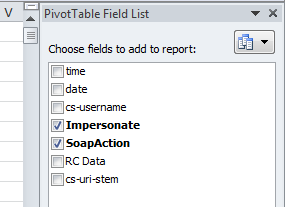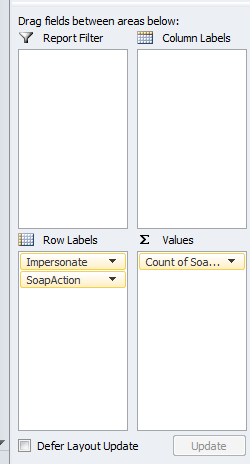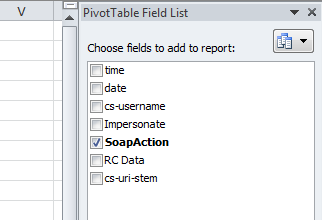Troubleshooting EWS requests using IIS logs with Logparser
The problem:
We have very valuable data inside of the IIS logs that can greatly assist in troubleshooting Exchange Web Service clients. The problem is that all of the data exists in one field (cs-uri-query) inside of the IIS logs.
An example cs-uri-query field for a EWS call:
;RC:111111ac-1111-1111-1111-111112c1111;Init>>Conn:0,HangingConn:0,AD:30000/30000/0%,CAS:54000/54000/0%,AB:30000/30000/0%,RPC:36000/36000/0%,FC:1000/0,Policy:DefaultThrottlingPolicy_3333333-3333-3333-3333-333333333333,Norm,Sub:5000/0;SoapAction=GetUserAvailability;AddressCount=1;MessageId=urn:uuid:db01111-da7c-4f46-b89d-1111be7aaaaa;Requester=S-3-3-33-3333223333-3333333333-3333673333-3323333;local=1;Threads.Worker.Available=1198;Threads.Worker.InUse=0;Threads.IO.Available=1194;Threads.IO.InUse=1;Failures=0;MailboxRPC.TimeTaken=0;MailboxRPC.RequestCount=0;AD.TimeTaken=0;AD.RequestCount=2;Request.CPU.Main=0;Local.FirstThreadExecute=0;Local.LongPole.Elapsed.TimeTaken=53;Local.LongPole.Elapsed.Destination=server.company.com;LocalLongPole.TimeTaken=3;LocalLongPole.RequestCount=28;LocalLongPole.Destination=server2.company.com;TotalLocal.TimeTaken=53;TotalLocal.RequestCount=1;Thread.CPU.LongPole.TimeTaken=15;Thread.CPU.LongPole.Destination=LocalRequest.Execute;Request.Phase.PreQuery=5;Request.Phase.RequestDispatcher.BeginInvoke=0;Request.Phase.RequestDispatcher.Complete=54;Request.Phase.PostQuery=0;Request.CPU.Total=15;TimeInAS=59;[C]Queues:0msec/Execute:59msec;End(61ms)>>Conn:1,HangingConn:0,AD:30000/29996/1%,CAS:54000/53940/1%,AB:30000/30000/0%,RPC:36000/35972/1%,FC:1000/0,Policy:DefaultThrottlingPolicy_333333-3333-3333-3333-aaaaaaaaaaaa,Norm[Resources:(DC)dc.company.comHealth:-1%,HistLoad:0),(DC)dc2.company.com(Health:-1%,HistLoad:0),(Mdb)DatabaseName(Health:-1%,HistLoad:0),],Sub:5000/0;
The solution:
We will utilize logparser purely for speed
The LogParser Query:
It took a bit of time to work around some of the logic, but this works well.
Logparser.exe -i:iisw3c "SELECT time, date, cs-username, substr(substr(cs-uri-query, index_of(cs-uri-query, 'Impersonate')),0,index_of(substr(cs-uri-query, index_of(cs-uri-query, 'Impersonate')),';')) AS [Impersonate], substr(substr(cs-uri-query, index_of(cs-uri-query, 'SoapAction')),0,index_of(substr(cs-uri-query, index_of(cs-uri-query, 'SoapAction')),';')) AS [SoapAction], substr(substr(cs-uri-query,index_of(cs-uri-query, 'RC')),0,index_of(substr(cs-uri-query, index_of(cs-uri-query, 'RC')),';')) AS [RC Data], cs-uri-stem, substr(substr(cs-uri-query, index_of(cs-uri-query, 'Execute')),0,index_of(substr(cs-uri-query, index_of(cs-uri-query, 'Execute')),';')) AS [Time to Execute] INTO c:\logs\out.csv FROM c:\logs\*.log Where cs-username = 'Domain\ServAcct' AND cs-uri-query LIKE '%SoapAction%'"
Note: output goes into the file specified after the INTO clause above. Input is taken from the FROM clause. Notice we are grabbing all .log files in a directory. We are also filtering for requests coming from one user, typipcally applications will authenticate as one user and Impersonate the intended target.
What this query does:
-Only fields that are sent by a specific user (Domain\ServAcct above)
Splits the csi-uri-query to pull out:
- who the above user is impersonating as
- what the soapaction is
- the RC field
- The Execution time
It took me a bit to understand the built in functions to sort the data we needed.
The output:
How fast is this?
On my (rather speedy) laptop with about 650 megs of logs:
Statistics:
-----------
Elements
processed: 827827
Elements
output: 325218
Execution
time: 11.02 seconds
Great, i see the data in Excel.... How can i make it useful?
Sorting and Charting in Excel is extremely helpful, I'll go through a few scernios that shed some light on our issue
Counts for each user:
Row Labels |
Count of SoapAction |
Impersonate:Domain\User1 |
1102 |
SoapAction=m:ConvertId |
293 |
SoapAction=m:CreateItem |
1 |
SoapAction=m:FindFolder |
22 |
SoapAction=m:FindItem |
310 |
SoapAction=m:GetFolder |
11 |
SoapAction=m:GetItem |
377 |
SoapAction=m:UpdateItem |
88 |
Impersonate:Domain\User2 |
1013 |
SoapAction=m:ConvertId |
285 |
SoapAction=m:CreateItem |
1 |
SoapAction=m:FindFolder |
22 |
SoapAction=m:FindItem |
352 |
SoapAction=m:GetFolder |
11 |
SoapAction=m:GetItem |
286 |
SoapAction=m:UpdateItem |
56 |
Counts for each Action:
Row Labels |
Count of SoapAction |
SoapAction=GetUserAvailability |
31 |
SoapAction=m:ConvertId |
65685 |
SoapAction=m:CreateItem |
1560 |
SoapAction=m:DeleteItem |
1013 |
SoapAction=m:ExpandDL |
12 |
SoapAction=m:FindFolder |
49536 |
SoapAction=m:FindItem |
102752 |
SoapAction=m:GetFolder |
24804 |
SoapAction=m:GetItem |
70584 |
SoapAction=m:ResolveNames |
76 |
SoapAction=m:UpdateItem |
9165 |
Grand Total |
325218 |
That looks great, how do I get that level of detail out of the logs?
Note: I am using Excel 2010
To Calculate Counts for each user:
- Open the .csv output in Excel
- Without selecting any cells, click insert, PivotTable
- At Select a Table or Range, the default should be all Cells, click New Worksheet
- On the new worksheet with the PivotTable click Impersonate and SoapAction under PivotTable Field List (upper right)
- Now drag SoapAction to the (Sum) Values box at the bottom right
- Now we will want to fix the sort to list the user with the highest number of requests first
- Highlight all of the values inside of “Count of SoapAction” column (not gathering the header or the total at the bottom)
- Click the Data tab
- Select Z to A to sort Largest to Smallest (Next to Sort, upper right)
To Calculate Counts for each Action:
- Open the .csv output in Excel
- Without selecting any cells, click insert, PivotTable
- At Select a Table or Range, the default should be all Cells, click New Worksheet
- On the new worksheet with the PivotTable click SoapAction under PivotTable Field List (upper right)
- Now drag SoapAction to the (Sum) Values box at the bottom right
Now look at the worksheet with the Pivot Table, you should see the data sorted correctly. Using the same technique you can sort or chart the data by time to get an idea of when the bulk of requests are coming in
-CaseyS
Comments
- Anonymous
January 01, 2003
Hello Andrew,
As of Exchange 2010 Sp2, you might have noticed that the EWS requests were moved out of the IIS logs. These can now be found in the EWS logs (MicrosoftExchange ServerV14LoggingEWS directory).
In the new format, pulling the same information out is much easier, for example:
SELECT To_Timestamp(Replace_str(Replace_str(Datetime,'T',' '),'Z',''),'yyyy-MM-dd hh:mm:ss.ll') AS DateTimeStamp, AuthenticatedUser, ImpersonatedUser, SoapAction, TotalRequestTime, To_LocalTime(DateTimeStamp) AS LocalTime
FROM '[LOGFILEPATH]'
Where index_of(DateTime,'#') <> 0
AND DateTimeStamp BETWEEN timestamp('2014/11/05 12:00:00', 'yyyy/MM/dd hh:mm:ss') AND timestamp('2014/11/05 12:05:00', 'yyyy/MM/dd hh:mm:ss') - Anonymous
March 24, 2015
Hi,
This looks really useful and would help us troubleshoot an EWS application. However, in the IIS logs, under cs-uri-query I am only seeing strings such as this...
&CorrelationID=;&cafeReqId=da4192fb-3461-4f4b-9256-76542c96bab3;
Do I need to increase the logging level?
thanks in advance - Anonymous
May 03, 2015
A lot of programmers will write code for EWS thinking that the code and some knowledge of EWS is all - Anonymous
May 11, 2015
Developers of applications which require access to user mailboxes often struggle with the choice between





